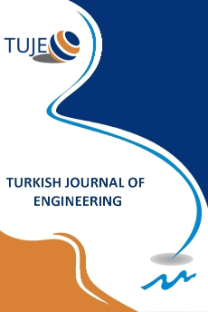DETERMINATION OF MALIGNANT MELANOMA BY ANALYSIS OF VARIATION VALUES
DETERMINATION OF MALIGNANT MELANOMA BY ANALYSIS OF VARIATION VALUES
___
- Andrea, F., Franz, J.H., Tobias, S., et al. (2018). "Nextgeneration-sequencing of advanced Melanoma: Which genetic alterations have an impact on systemic therapy response?" J Clin Oncol, Vol.36, No.15, suppl. e21557- e21557.
- Audibert, C., Stuntz M., and Glass, D. (2018). "Treatment Sequencing in Advanced BRAF-Mutant Melanoma Patients: CurrentPractice in the United States", Journal of Pharmacy Technology, Vol.34, No.1, pp. 17–23.
- Bolger, A.M., Lohse M., Usadel B. (2014). "Trimmomatic: a flexible trimmer for Illumina sequence data", Bioinformatics, Vol. 30, No.15, pp. 2114-2120.
- Bukowski, R, Guo, X, Lu Y, et al. (2017) “Construction of the third-generation Zea mays haplotype map.” Gigascience. Vol. 7, No. 4, pp. 1-12.
- Bulmer, M. G. (1971). "The Effect of Selection on Genetic Variability," The American Naturalist, Vol.105, No. 943, pp. 201-211.
- Ebbert, M.T., Wadsworth, M.E., Staley, L.A., et al. (2016) "Evaluating the necessity of PCR duplicate removal from next-generation sequencing dat aand a comparison of approaches", BMC Bioinformatics. Vol.17, No. 7, pp. 239.
- Gao, J., Wan C., Zhang H., et al.(2017) "Anaconda: AN automated pipeline for somatic COpyNumber variation Detection and Annotation from tumor exome sequencing data", BMC Bioinformatics, Vol.18, No.1, pp:436.
- Griffiths-Jones, S., Grocock, R. J., Dongen, S., Bateman, A., Enright, A. J. (2006). "miRBase: microRNA sequences, targets and gene nomenclature", Nucleic Acids Research, Vol.34, No.1, pp.140–144.
- Haberer, G., Spannagl, M., "Hands-on Tutorial on SNP Calling" Plant Genome and Systems Biology Group/PGSB (Access Date: 01.11.2018)
- Hsu, Y.C., Hsiao, Y.T., Kao, T.Y., Chang, J.G., Shieh, G.S. (2017). Detection of Somatic Mutations in Exome Sequencing of Tumor-Only Samples", Scientific Reports 7, 15959.
- Kearse, M., Moir, R., Wilson, A., et al. (2012). "Geneious Basic: An integrated and extendable desktop software platform for the organization and analysis of sequence data." Bioinformatics, Vol.28, No.12, pp. 1647–1649.
- Koboldt, D. C., Steinberg, K. M., Larson, D. E., Wilson, R. K., & Mardis, E. R. (2013). “The next-generation sequencing revolution and its impact on genomics.” Cell, Vol.155, No.1, pp. 27-38.
- Koboldt, D.C., Chen, K, Wylie, et al. (2009). “VarScan: variant detection in massively parallel sequencing of individual and pooled samples.” Bioinformatics Vol. 25, No. 17, pp. 2283-2285.
- Kroigard, A.B.,Thomassen M., Lænkholm A-V., Kruse T.A., Larsen M.J. (2016) "Evaluation of Nine Somatic Variant Callers for Detection of Somatic Mutations in Exomeand Targeted Deep Sequencing Data." PLoS One. Vol.11, No.3, e0151664.
- Laila, N., Kelsey, M., Jordan, R., (2016). "Cytology Sample Based Next-Generation Sequencing for Metastatic Melanoma: A Feasible and UsefulTool", Journal of the American Society of Cytopathology, Vol.5, No.5, p. 67.
- Larson, D.E., Harris C.C., Chen K., et al. (2011). "Somatic Sniper: identification of somatic point mutations in whole genome sequencing data." Bioinformatics. Vol.28, No.3, pp. 311-7.
- Leipzig, J. (2016). "A review of bioinformatic pipeline frameworks", Brief Bioinform. Vol.18, No. 3, pp. 530- 536.
- Li, H., Handsaker, B., Wysoker, A., et al. (2009). "The Sequence Alignment/Map format and SAM tools", Bioinformatics. Vol. 25, No. 16, pp. 2078-2079.
- McCormick, R.F., Truong, S.K., Mullet, J.E. (2015). "RIG: Recal ibration and inter relation of genomic sequence data with the GATK", G3 (Bethesda). Vol.5, No. 4, pp. 655-665.
- McKenna, A., Hanna, M., Banks, E., et al. (2010). “The Genome Analysis Toolkit: A Map Reduce framework for analyzing next-generation DNA sequencing data.” Genome Research. Vol.20, No. 9, pp. 1297-1303.
- Moore, J.H., Asselbergs, F.W., Williams, S.M. (2010) "Bioinformatics challenges for genome-wide association studies." Bioinformatics, Vol.26, No.4, pp. 445–455.
- Nielsen, R., Paul, J. S., Albrechtsen, A., Song, Y. S. (2011). "Geno type and SNP calling from nextgeneration sequencing data" Nat Rev Genet. Vol.12, No. 6, pp. 443-451.
- Ogasawara, T., Cheng, Y., Tzeng, T-H.K. (2016) "Sam2bam: High-Performance Framework for NGS Data Preprocessing Tools." PLoS One. Vol. 11, no.11,. e0167100.
- Peter, J. A., Cock, T.A., Jeffrey, T., et al. (2009). “Biopython: freely available Python tools for computational molecular biology and bioinformatics.” Bioinformatics, Vol.25, No. 11, pp. 1422–1423.
- Rihtman, B., Meaden, S., Clokie, M.R., Koskella, B., Millard, A.D. (2016). "Assessing Illumina technology for the high-through put sequencing of bacteriophage genomes." PeerJ. Vol. 4, e2055.
- Saunders, C.T., Wong, W.S., Swamy, S., Becq, J., Murray, L,J,, Cheetham, R.K. (2012). "Strelka: accurate somatic small variant calling from sequenced tumornormal sample pairs." Bioinformatics, Vol.28, No. 14, pp. 1811-1817.
- Sipos, B., Massingham, T., Stütz, A.M., Goldman N. (2012) "An Improved Protocol for Sequencing of Repetitive Genomic Regions and Structural Variations Using Muta genes is and Next Generation Sequencing." PLoS One Vol. 7, No. 8, e43359.
- Sun, Z., Bhagwate, A., Prodduturi, N., Yang, P., Kocher, J. P.A. (2017) "Indel detection from RNA-seq data: tool evaluation and strategies for accurate detection of actionable mutations", Briefings in Bioinformatics, Vol. 18, No. 6, pp. 973–983.
- Vogelstein, B., Papadopoulos, N., Velculescu, V.E., Zhou, S, Diaz LA, Kinzler KW. (2013). “Cancer genome landscapes.” Science. Vol. 339, No. 6127, pp. 1546-1558.
- Walker, B.J., Abeel, T., Shea, T., et al. (2014) "Pilon: an integrated tool for comprehensive microbial variant detection and genome assembly improvement." PLoSOne. Vol. 9, No. 11, e112963.
- Yang, H., Wang, K. (2015). "Genomic variant annotation and prioritization with ANNOVAR and wANNOVAR", NatProtoc. Vol.10, No.10, pp. 1556-66.
- Zhang J., Chiodini, R., Badr, A., Zhang, G. (2011). "The impact of next-generation sequencing on genomics." J Genet Genomics. Vol. 38, No. 3, pp.95-109.
- ISSN: 2587-1366
- Yayın Aralığı: 4
- Başlangıç: 2017
- Yayıncı: Mersin Uüniversitesi
MODELLING AND OPTIMIZATION OF THE EXAM INVIGILATOR ASSIGNMENT PROBLEM BASED ON PREFERENCES
USER-ORIENTED FILE RESTORATION FOR OPERATING SYSTEMS
Ahmet Kürşat ESİM, Hilal KAYA, VEYSEL ALCAN
MECHANICAL AND WEAR CHARACTERISATION OF QUARRY TAILINGS REINFORCED A6063 METAL MATRIX COMPOSITES
Stephen Durowaye, Olatunde Sekunowo, Babatunde Bolasodun, Isaac Oduaran, Ganiyu Lawal
Stephen DUROWAYE, Olatunde SEKUNOWO, Babatunde BOLASODUN, Isaac ODUARAN, Ganiyu LAWAL
DETERMINATION OF MALIGNANT MELANOMA BY ANALYSIS OF VARIATION VALUES
Veysel Alcan, Ahmet Kürşat Esim, Hilal Kaya
PREDICTINGTHE ENERGY PRODUCTIONOF A ROOFTOP PV PLANT BY USING DIFFERENTIAL EVOLUTION ALGORITHM
